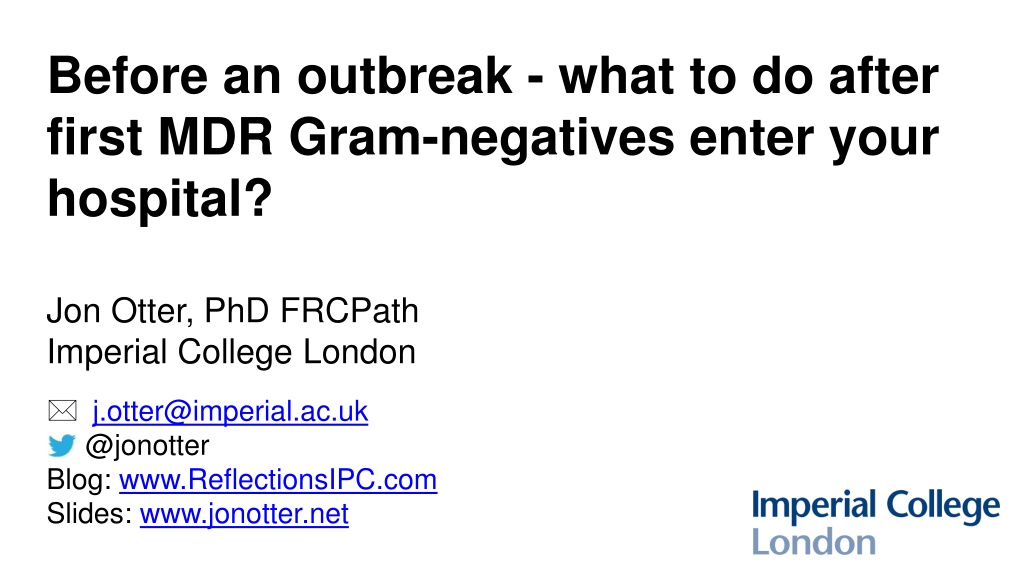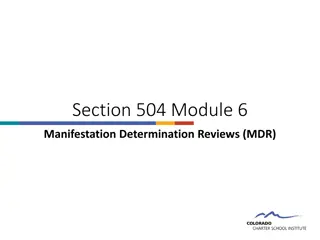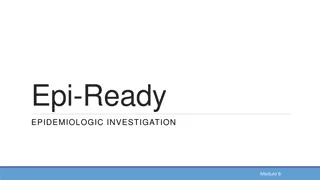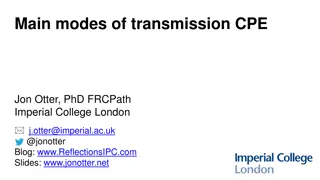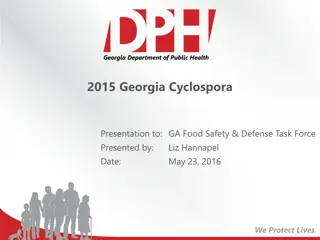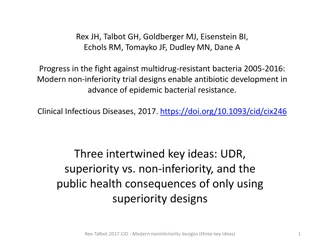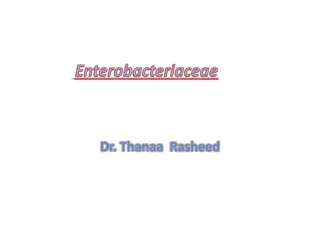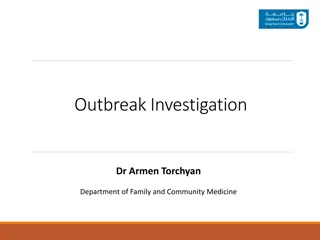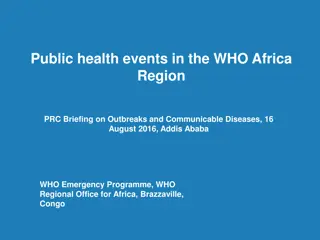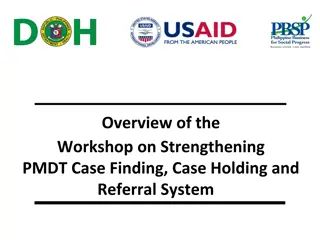Managing MDR Gram-negative Enterobacteriaceae Outbreaks in Hospitals: Response Strategies and Best Practices
Hospitals face a growing threat from multidrug-resistant Gram-negative bacteria, such as Acinetobacter baumannii and Klebsiella pneumoniae. This article discusses the emergence of carbapenem-resistant Enterobacteriaceae in Europe and outlines response strategies, including lab screening, communication methods, cleaning protocols, hand hygiene, antibiotic stewardship, and active screening to control outbreaks effectively.
- MDR Gram-negative bacteria
- Hospital outbreaks
- Antibiotic resistance
- Infection control
- Response strategies
Download Presentation

Please find below an Image/Link to download the presentation.
The content on the website is provided AS IS for your information and personal use only. It may not be sold, licensed, or shared on other websites without obtaining consent from the author. Download presentation by click this link. If you encounter any issues during the download, it is possible that the publisher has removed the file from their server.
E N D
Presentation Transcript
Before an outbreak - what to do after first MDR Gram-negatives enter your hospital? Jon Otter, PhD FRCPath Imperial College London j.otter@imperial.ac.uk @jonotter Blog: www.ReflectionsIPC.com Slides: www.jonotter.net
Rising threat from MDR-GNR % of all HAI caused by GNRs. % of ICU HAI caused by GNRs. Acinetobacter baumannii Pseudomonas aeruginosa Stenotrophomonas maltophilia Klebsiella pneumoniae Escherichia coli Enterobacter cloacae Non-fermenters CPO Enterobacteriaceae CPE Hidron et al. Infect Control Hosp Epidemiol 2008;29:966-1011. Peleg & Hooper. N Engl J Med 2010;362:1804-1813.
CRE in Europe, 2016 % invasive K. pneumoniae isolates resistant to carbapenems EARS-Net 2018.
Emergence of CRE in Europe, 2005-2016 70 % invasive K. pneumoniae isolates 60 resistant to carbapenems 50 Greece Italy Malta Portugal Romania UK 40 30 20 10 0 2005 2006 2007 2008 2009 2010 2011 2012 2013 2014 2016 2015 EARS-Net 2018.
Carbapenem-resistant P. aeruginosa in Europe, 2005-2016 80 % invasive P. aeruginosa isolates 70 resistant to carbapenems 60 Greece Italy Malta Portugal Romania UK 50 40 30 20 10 0 2005 2006 2007 2008 2009 2010 2011 2012 2013 2014 2015 2016 EARS-Net 2018.
K. pneumoniae NDM outbreak; total number of cases 8 cases first identified by clinical culture, 32 by screening culture; of these 32, 14 had a subsequent positive clinical culture 12 Number of new cases each month 10 8 6 4 2 0 Mar-15 Jul-14 May-15 Jul-15 Apr-15 Oct-14 Oct-15 Feb-15 Aug-14 Sep-14 Nov-14 Dec-14 Aug-15 Sep-15 Jan-15 Jun-15 Otter et al. Sci Rep 2017;7:12711.
Outbreak response Lab Screening Comms methods Cleaning / disinfection / decon Peer learning Hand hygiene External reviews Antibiotics stewardship Applied research
Hand hygiene Antibiotic stewardship HCW screening Cleaning / disinfection Active screening Decol. MDR-GNR Toolbox Contact precautions Cohorting staff / patients Note flagging Env. screening Education Otter et al. Clin Microbiol Infect 2015 2015;21:1057 1066.
Hand hygiene Antibiotic stewardship HCW screening Cleaning / disinfection Active screening Decol. MDR-GNR Toolbox Contact precautions Cohorting staff / patients Note flagging Env. screening Education Otter et al. Clin Microbiol Infect 2015 2015;21:1057 1066.
Who should be screened at the time of hospital admission? Nobody All admissions to high risk specialities PLUS risk factor based all admissions Risk factor based screening of all admission All admissions to high risk specialties Everybody MDR A. baumannii (n=108) 0 10 20 % respondents 30 40 50
How do I screen for CPE? Rectal swab is the best sample Insert no more than 2cm into rectum Twist gently and withdraw Ideally want to see faeces on swab. Patient and staff education as to why this is needed in order to overcome taboos Alternate specimen is stool sample, but have to wait for the patient to go
Can I swab your rectum please? Factors associated with patients declining to provide a rectal swab were: younger age (odds ratio (OR) 0.99, 95% confidence interval (CI) 0.99-1.00) female gender (OR 1.26, CI 1.04-1.52), transfers from other hospitals (OR 1.77, CI 1.07-2.93) or an unknown admission route (OR 1.61, CI 1.09-2.37), admission before the change in study description (OR 0.39, CI 0.31-0.48) the staff member who consented the patient (p<0.001); ethnicity was not a significant factor. Dyakova et al. Clin Microbiol Infect 2017;23:577.e1-577.e3.
Improving screening compliance Dyakova et al. Clin Microbiol Infect 2017;23:577.e1-577.e3.
Distant large problems vs. small local ones? CPE introductions come from hospitals within a regional referral network, even if the prevalence in another referral network is much higher (more than 100x higher, in fact)! Donker et al. BMC Med 2017.
Hand hygiene Antibiotic stewardship HCW screening Cleaning / disinfection Active screening Decol. MDR-GNR Toolbox Contact precautions Cohorting staff / patients Note flagging Env. screening Education Otter et al. Clin Microbiol Infect 2015 2015;21:1057 1066.
What should be used for terminal disinfection following a case? Sodium hypochlorite ( bleach ) HPV room decon UV room decon Depends on context MDR A. baumannii (n=109) CPE (n=147) No enhanced disinfection required 0 10 20 30 40 50 % respondents
Contaminated surfaces Mitchell et al. J Hosp Infect 2015;91:211-217.
MDR-GNR cleaning & disinfection checklist Clean / declutter Monitor cleaning process (e.g. fluorescent markers) All equipment disinfected before leaving room Enhanced daily disinfection using bleach Terminal disinfection using bleach or, ideally, H2O2 vapor1-3 1. Gopinath et al. Infect Control Hosp Epidemiol 2013;34:99-100. 2. Snitkin et al. Sci Transl Med 2012;4:148ra116. 3. Verma et al. J Infect Prevent 2013;7:S37.
Contaminated sinks / drains CPE (K. pneumoniae) acquisition and clinical infection halved through improved management of sinks (OR = 0.51 for acquisions, and 0.29 for clinical cultures) (n=~7,500 pts). Mathers et al. Clin Infect Dis 2018 in press.
Enterobacteriaceae vs. non-fermenters Share Gram stain reaction Concerning AMR Differ Risk factors & at-risk population Potential for epidemic spread Infection profile & mortality Prevalence Colonisation site & duration Transmission routes Resistance profile & mechanisms
What is the single most important intervention to reduce the spread of MDR- GNR in hospitals? Cleaning / disinfection Antibiotic stewardship Screening and isolation Hand hygiene 0 10 20 30 40 50 60 70 % respondents (n=135)
When the first MDR-GNR (especially CPE) enter your hospital Get Get screening communicating Get out the disinfection big guns
Before an outbreak - what to do after first MDR Gram-negatives enter your hospital? Jon Otter, PhD FRCPath Imperial College London j.otter@imperial.ac.uk @jonotter Blog: www.ReflectionsIPC.com Slides: www.jonotter.net
